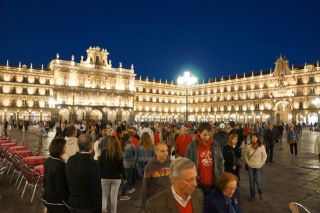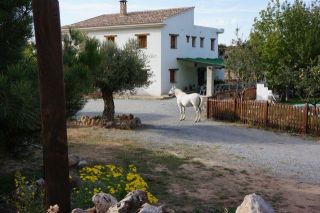Personality
Culture Shock: Spain Versus America
Are Americans and Spaniards psychologically different?
Posted October 14, 2012
While I was traveling around the Iberian Peninsula last year, Spain was receiving some bad press back on the other side of the Atlantic – as an object lesson in how not to do things. I did not spent any of my time here with bankers or politicians, so I haven’t learned much about the broader economic crisis in Spain. But I did spend some time walking around the streets of Salamanca, Sevilla, and Barcelona, and much of that time involved discussions about culture and evolution with several Spanish psychologists, so I learned something about the differences (and the similarities) between Spanish and American societies.
Let’s start with the differences, since it is always interesting to compare “us” to “them.” Perhaps most salient is the number of people on the street at almost any time of the day, and long into the night. The other night I was wandering around the streets of Alicante (a medium-sized town on the Mediterranean coast south of Valencia). It was approaching 9 p.m. on a Sunday night, yet the squares were crowded with hundreds and hundreds of people, including young children, college students, and elderly couples, most sitting in large groups outside bars, sipping beverages, munching on tapas, and watching a soccer match. I enclose two pictures I took in the same square in Salamanca, once in the afternoon, then again at night (notice there are lots of people at both times).

Salamanca square by day

Salamanca square by night
This is related to another salient difference: the Spanish keep a schedule very different from los Americanos. I have occasionally been shocked to find that most Spanish restaurants are closed at noon, and many other businesses close for two or three hours in the afternoon, during the “siesta” time (which has persisted despite Spain’s union with Germany). As I understand it, Spaniards take a two-hour lunch that may begin at 2 or 3 in the afternoon, or later. That lunch may well be accompanied by a glass of cerveza or vino, and that may be followed by a short nap. Spaniards then head back to work during the hours when most Americans are packing up to head home for dinner. Dinner in Spain starts at 9 P.M., and prime time for television viewing is 11 P.M. All that seems very unnatural to me! From the perspective of an American business model, it hardly seems efficient, but the tapas sure are tasty.
There is another aspect of Spanish culture that feels very natural, but that is rather un-American. Spaniards are shockingly hospitable, even to strangers. The other day I was lost in my rental car, driving around the tiny village of Guejar Sierra, where the streets are hopelessly maze-like, and barely wide enough for one car to pass between the ancient walls. My GPS had gone haywire (turn left, turn right, turn left, turn right, no, no, wait, that’s wrong, now make a U-turn….). I finally came across a street sign that said: “Vd. Esta aqui” (you are here) but I couldn’t tell where “aqui” was at all. Then two young fellows in police uniforms pulled up, in a Jeep marked “Guardia Civil.” When I waved to them, and said I was “perdido,” they looked at my iPad map, shook their heads a couple of times, and waved at me to follow them. At this point, they proceeded to escort me through the maze of the town, down several kilometers of narrow country roads, and finally to the entrance of the Casa Rural Fuente la Teja where I was staying (smack dab in a very lovely stretch of the middle of nowhere, down a winding road called Calle de Diez y Ocho Caños; I include a picture, in case you’ve never been nowhere in Spain).

Casa Rural Fuente in Guejar Sierra (and they mean "rural")
My host at the University of Malaga, Luis Gomez-Jacinto, is probably the most hospitable person I have ever met in my life. He not only wrote a grant to cover my travel expenses for our work together, but then he and his wife, Maribel Hombrados-Mendieta, gave me the keys to their summer house near the beach on the Gold Coast (with a lovely view of the Mediterranean from the patio). Not only that, but they set me up with their second car, a refrigerator full of groceries, a Spanish cell phone, and a special attachment for my computer – which allows me to access internet everywhere while I am in Spain. And then, when I told Luis I was planning a visit to the nearby city of Sevilla, he responded by taking me on a 4-day guided tour of what he called “Deep Spain,” including not only Sevilla and Salamanca (where Luis’s family lives), but also two days in a region called the Extremadura, a shockingly pastoral and beautiful hilly region along the Portuguese border (where his grandparent’s home still stands in a charming little pueblo called Torre de Don Miguel, and from whence came many of the Conquistadors who settled America, including Cortez, Pizarro, deSoto, and Balboa).
While we were traveling, Luis and I did not stay in hotels, but were welcomed into the homes of his parents in Salamanca, and of his brother-in-law in Sevilla, besides staying in the grandparental house in Torre don Miguel that Luis still shares as a vacation home with his parents and brother and sister). This illuminates another difference between Spain and its former colony in North America. Americans tend to be more “individualistic” than “collectivistic.” Individualists tend to focus more on themselves as isolated units, and to place less value on family ties. Indeed, America is usually ranked as the world’s most individualistic society. Spaniards are more collectivistic. Luis’s connections to his family are not unusual; another colleague told me that Spanish children typically do not go away to college, but live with their families until they marry, which in this era may not happen until they are over 30. And then, they prefer to take jobs near their families. Veronica Benet-Martinez is a psychologist who broke the mold: she studied culture and personality at U.C. Davis, did a post-doc at U.C. Berkeley, spent five years at the University of Michigan, and was on the faculty at U.C. Riverside when I met her. But after spending half her life in the U.S., she got a chance to take an academic job back in her home-town of Barcelona, and she was willing to sacrifice the American life that U.S. politicians think is so perfect. She now lives within walking distance of her office at Pompeu Fabra University, and a short Metro-ride to the homes of her sister and mother.*
I could go on about the various differences, but in the end, I would argue that the similarities between human beings in different cultures are much more important than the differences. Like Americans, Spaniards spend a good deal of every day trying to get along with their colleagues at work, worrying about how their family members are doing, and gossiping with their friends about politics, the economy, and other people’s love lives (Antonio Banderas is from Malaga, and his love life back in the U.S. still makes a hot topic on this side of the Atlantic). Indeed, Veronica Benet-Martinez has a highly cited paper, with Oliver John, examining whether the so-called Big Five personality factors, which were originally found in North American samples, would apply in Spain. That research led to the conclusion of: “little evidence for substantial cultural differences in personality structure at the broad level of abstraction represented by the Big Five dimensions.” In Spain, as in the U.S., other people care whether you are agreeable (vs. disagreeable), whether you are conscientious (vs. sloppy and undependable), whether you are extraverted (vs. shy), whether you are neurotic (vs. emotionally stable), and whether or not you are intellectually oriented and creative.
My hosts Luis Gomez-Jacinto and Maribel Hombrados-Mendieta have a paper in which they examined age differences in men’s and women’s marriage choices. Using Spain’s Marriage Records from 1976 to 2006 (with a sample of 13,292,902 people), they replicated the exact same pattern Rich Keefe and I had found in North America: As Spanish men got older, they choose increasingly younger partners for marriage, whereas females generally prefer older partners throughout their life span. They concluded: “These results provide new evidence for the evolutionary model of age preferences in choosing a partner and for the universality of the sexual attraction mechanism.” (see my blog The Mind as a Coloring Book for a description of our research on age preferences in men and women).
As we were driving around in Deep Spain, Luis and I were talking about a chapter we are writing for a series called Advances in Culture and Psychology, in which we will explore the ecological factors that influence cultural differences and similarities. Luis can speak English, but has a hard time understanding Americano when it is spoken at conversational speed. I can, on the other hand, transmit some Spanish, but am dazzled on the receiving end (when I ask “donde esta el baño?” I only comprehend one word out of four from the rapid response, so must pay careful attention to the accompanying hand gestures if I hope to make it to said baño in time). But despite the fact that Luis’s half of our conversations was in halting English, and mine was in broken Spanish, we managed to understand one another perfectly, and it was clear that our responses to most social situations are precisely the same.
What’s fascinating to me is that an evolutionary approach to human psychology, which used to be considered politically incorrect, turns out to be a perfect antidote to ethnocentrism, leading us to focus on our commonalities with other human beings, instead of our differences. All we need now is the old theme song from Coca-Cola: “I’d like to teach the world to sing in perfect harmony…” (sung in Spanish, which I’m sure is out there somewhere!)
Douglas Kenrick is author of Sex, Murder, and the Meaning of Life: A psychologist investigates how evolution, cognition, and complexity, are revolutionizing our view of human nature.
Related blogs:
The Mind as a Coloring Book: Universal psychological mechanisms yield surprising cultural diversity.
The Mind as a Coloring Book II: Why cultural diversity does not mean a blank slate mind.
References:
Benet-Martínez, V.; John, O. P. (1998). Los Cinco Grandes across cultures and ethnic groups: Multitrait-multimethod analyses of the Big Five in Spanish and English. Journal of Personality and Social Psychology, 75, 729-750.
Gomez-Jacinto, L., & Hombrados-Mendieta, M.I. (2011). Evolutionary analysis of age difference in choice of partner in marriages celebrated in Spain from 1976 to 2006, Revista de Psicología Social, 26, 73-89.
Kenrick, D.T., & Keefe, R.C. (1992). Age preferences in mates reflect sex differences in mating strategies. Behavioral & Brain Sciences, 15, 75- 91.
*Incidentally, after reading this, Prof. Benet-Martinez pointed out that the folks up in Barcelona don't live the Southern Spanish lifestyle, with those 2 hour breaks and siestas. Besides no siestas, she points out that Catalonia has a long history of trying to preserve its different culture, language, and values, and is now asking for a referendum to separate from Spain. I did observe, however, that when she and her colleagues took me for lunch, it was at 2 P.M., and for dinner, the restaurant didn't open till 7:30 or 8:00! But of course, the more important point is that people everywhere: whether in Spain, Catalonia, Spokane, and California, have the same human nature, regardless of when they take their lunches or naptimes.




